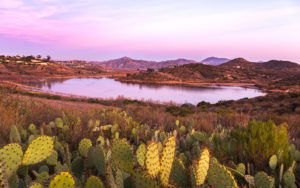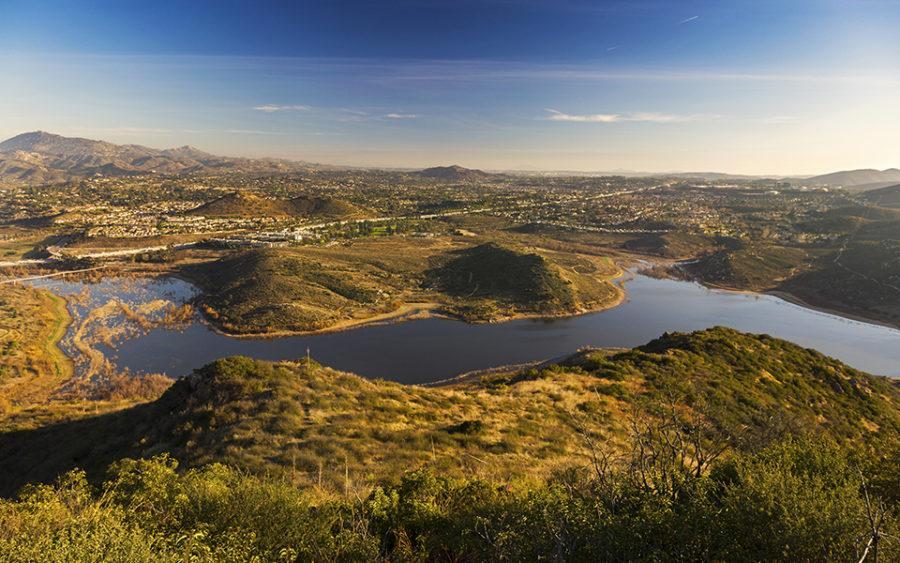Lake Hodges at two-thirds capacity as forecast calls for more rain
Late afternoon sun casts golden light on the eastern side of Lake Hodges near Escondido in this February 2018 image. (Photo by Autumn Sky Photography; iStock Getty Images)
March 6, 2019
More rain in one of San Diego County’s rainiest of winter seasons is expected to drop an inch or two across the region through Friday, but Lake Hodges Dam is holding strong.
The dam last overflowed February to March 2011. It also overflowed in February 2005. However, despite a Pineapple Express of rains this season, while Lake Hodges has filled more rapidly lately, its dam looks to continue standing tall and holding firm.
The lake was at 68.1 percent capacity as of this week, according to the city of San Diego’s Public Utilities Department, which has owned and operated the reservoir and dam since purchased in 1925. Hodges Reservoir was created with the building of Hodges Dam on San Dieguito River in 1918.
Lake Hodges’ current depth was 105 feet, 10 feet below capacity. Even if it reached capacity, water could be released into nearby Olivenhain Reservoir if necessary.
Other area reservoirs varied so far as water storage. Lake Murray (La Mesa) was 88 percent full. Lower Otay was 82.9 percent full. Miramar was 82.2 percent full. On the other end of the spectrum, Barrett Reservoir was 42.9 percent full. Sutherland was 39.4 percent full. El Capitan was 33.8 percent full.
Dana Friehauf, resource manager with the San Diego County Water Authority, which manages the county’s water supply, said the rainfall captured in the reservoirs will allow the county to import less water.
Rain, rain, more on the way
Residents can expect heavy but scattered showers for the rest of the week, NBC 7 Meteorologist Sheena Parveen said.
From Wednesday to Friday, anywhere from a half inch to an inch of rain may fall across San Diego County. Escondido, San Marcos and the county are about 2 inches above average rainfall for the year.
Isolated showers were reported Tuesday, with a better chance for scattered showers Wednesday into Thursday. Yet another system will bring a chance for showers on Friday, according to the National Weather Service at Rancho Bernardo.
With 14 of the last 20 water years having been drier than average, forecasters say it’s not unusual for recent rainfall to surprise Californians.
“We’ve been lulled into a new normal with so much drought in the last several years,” said Miguel Miller, a meteorologist with the National Weather Service. “Now when it does rain normally it seems like a lot. We’re not on a record pace, but we are definitely well above average.”
There are 24 reservoirs in the county. About 10 percent of the county’s water supply comes from those reservoirs, Friehauf said. Over 70 percent of the county’s water comes from the Colorado River.
Friehauf said that all of the rain is increasing the elevation of the county’s reservoirs significantly. For example, at Lake Hodges near Escondido there’s been a 12-foot elevation increase, and at El Capitan near Alpine the reservoirs are now 16 feet higher.
California no longer in a drought
California is not considered to be in drought-like conditions right now, according to the state’s Department of Water Resources.
The department looks at drought conditions based off precipitation, snowpack and reservoir levels.
“All of those are healthy right now,” DWR’s Chris Orrack said. “They’re all above average.”
He shared some details about reservoir levels in Northern California.
Shasta Lake is at 119 percent above historical average, he said. The state’s biggest reservoir rose 39 feet in February alone and is now only 24 feet from its rim.
Folsom Lake Reservoir near Sacramento is at 110 percent of its historical average.
The Don Pedro Reservoir near Yosemite is at 115 percent.
The Sierra snowpack has more than doubled in the last month alone.
“We’ll find out how much water it’s holding when officials take that measurement in April,” Orrack said.
“Still — conservation is a must,” he emphasized, saying that California residents need to be ready for when those drought conditions come back.
Back to Lake Hodges
Since Santa Fe owns a share of the water captured in Lake Hodges, local rainfall means a greater supply of cheaper local water for the district and its customers. In recent years, the supply of local water has been limited.

The reservoir also serves the San Dieguito Water District — not surprisingly, given the original premise for the dam and reservoir was to pave the way for the creation of upscale homes around Rancho Santa Fe.
When full, the reservoir has 1,234 surface acres, a maximum water depth of 115 feet and 27 shoreline miles. Hodges Reservoir has a water storage capacity of 30,251 acre-feet. Water levels are monitored weekly.
The spillover that began Feb. 26, 2011, and ran into March that year turned normally fast-flowing two-lane Del Dios Highway into a parking lot as people from throughout the county flocked to see the rare sight of water cascading over the dam 115 feet below to Del Dios Gorge, the pathway of the San Dieguito River.
In fact, the dam became the county’s leading tourist attraction akin to the mass wildflower bloom during the spring following the devastating 2007 Witch Creek Fire. California Highway Patrol officers and San Diego County sheriff’s deputies were summoned to maintain order as people snapped photos, shot videos and did their social networking 2011-style.
Lake Hodges Reservoir overflowed in February and March 2005 following the last episode of heavy, sustained rainfall. The lake had been only 20 percent full in October 2004 following years of drought.
The 2005 event likewise turned the dam into one of San Diego County’s leading tourist attractions for a month with pedestrians overflowing normally bustling Del Dios Highway, turning it into a virtual parking lot.
Prior to that, the lake overflowed in 1995 and in the early 1980s.
The 1995 spill event resulted in 150 horses from the Del Mar Fairgrounds and Showpark horse arena being evacuated from waist-deep water after heavy rains and a Hodges spill. Each spillover event attracted thousands to the bluffs overlooking the dam.
The 1980s overflow caused serious flooding because the mouth of the river hadn’t been cleared. It was cleared all along the water’s path after that.
This story is published through a sharing agreement with The Escondido Grapevine, an independent news site covering inland North County.
encinitas current







